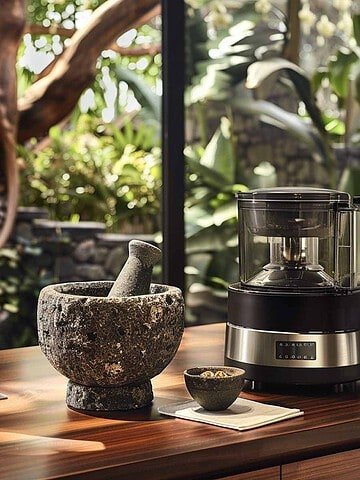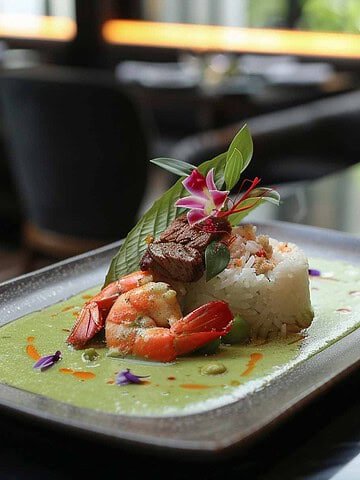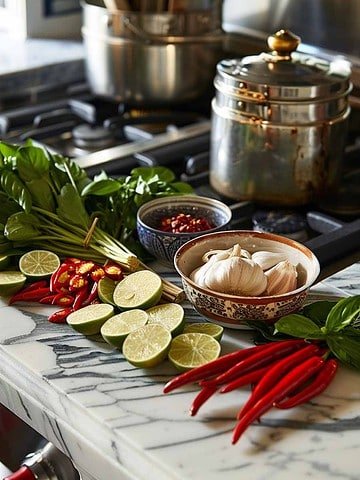
Thai culinary traditions are a vibrant tapestry woven with ancient techniques, communal rituals, and a deep reverence for fresh, aromatic ingredients. This article delves into the timeless artistry of Thai cooking methods, their significance in family and community life, and their adaptation to contemporary tastes and lifestyles.
Techniques Passed Down Through Generations
Thai cuisine is renowned for its rich, diverse flavors that stem from the artful combination of spicy, sweet, sour, and salty tastes. The careful preparation methods involve a delicate balance of fresh ingredients and aromatic herbs and spices, resulting in a culinary experience that is both vibrant and delightful. Many of these techniques have been cherished and refined over centuries. The fragrant curry pastes and the delicate art of steaming sticky rice in bamboo baskets are each a testament to the meticulousness and dedication of Thai culinary tradition.
The preparation of curry pastes exemplifies this meticulousness, where fresh herbs and spices like lemongrass, galangal, and kaffir lime leaves are pounded together using a mortar and pestle. This traditional method not only releases essential oils but also ensures a depth of flavor that forms the foundation of many Thai dishes, such as Green Curry or Tom Yum Soup.
Similarly, the art of steaming sticky rice in bamboo baskets preserves its unique texture. It enhances its natural sweetness, making it an indispensable accompaniment to dishes like Som Tum (Green Papaya Salad) or Khao Niew Moo Ping (Grilled Pork Skewers).
The culinary methods passed down through generations in Thailand are not just traditions; they embody the country's rich gastronomic heritage.
Role of Family and Community
Collective Preparation and Sharing of Festival Foods
In Thai culture, food is a centerpiece of communal gatherings and festive celebrations. The preparation of special dishes becomes a shared experience among family members and neighbors, fostering a sense of warmth and unity that is unique to Thai culture.
During festivals like Songkran (Thai New Year) or Loy Krathong, families come together to prepare elaborate feasts that showcase the diversity and abundance of Thai cuisine. From the intricate folding of banana leaves for Khanom Tom (sweet coconut rice balls) to the vibrant display of ingredients for a traditional Yum (Thai salad), these rituals honor cultural traditions and foster bonds of kinship and unity.
Cooking together is a testament to the spirit of generosity and hospitality deeply ingrained in Thai culture. During these moments, recipes are handed down, techniques are taught with patience and pride, and the essence of Thai identity is preserved through the art of food.
Modern Influences
Adaptation of Traditional Recipes and Techniques
Thai culinary traditions face new opportunities and challenges in today's globalized world as they adapt to modern tastes and lifestyles. While traditional techniques remain integral to authentic Thai cooking, there is also a growing trend towards innovation and fusion.
Chefs and home cooks alike are reinterpreting classic dishes to cater to contemporary palates without compromising on authenticity. For example, traditional Pad Thai, with its balance of sweet, sour, and salty flavors, has evolved to include variations with modern twists, such as using tofu or seafood instead of the traditional shrimp or chicken. Similarly, the use of food processors has made the preparation of curry pastes more efficient, while still maintaining the traditional flavors and aromas.
Furthermore, advances in kitchen technology, such as electric rice cookers and food processors, have simplified the preparation of elaborate dishes, making Thai cuisine more accessible to a global audience while maintaining its authenticity and flavor profile.
Despite these innovations, there remains a steadfast commitment among Thai communities to uphold culinary traditions. In Thailand's bustling markets and family kitchens, traditional recipes for curry pastes, spicy dips like Nam Prik, and refreshing herbal drinks like Lemongrass Tea are safeguarded and celebrated, ensuring that the essence of Thai cuisine continues to thrive.
Conclusion
Thai culinary techniques encompass more than just cooking; they celebrate culture, community, and creativity. As Thailand embraces the opportunities of a modern world, the preservation of traditional cooking methods serves as a bridge between the past and the future, honoring the wisdom of ancestors while embracing innovation. These techniques also play a crucial role in promoting cultural exchange and understanding, enabling individuals from around the globe to savor the diverse and exquisite tastes of Thai cuisine.
Whether it's the rhythmic pounding of spices in a mortar and pestle or the joyful sharing of a festive meal, Thai culinary traditions embody the essence of hospitality, generosity, and cultural pride. They remind us that food is not just sustenance but a reflection of identity, history, and the connections that bind us as a worldwide community.
As we continue to explore the richness of Thai culinary heritage, let us cherish the traditions that have shaped our tastes and celebrate the diversity that makes Thai cuisine a masterpiece of flavors, colors, and stories.





Leave a Reply